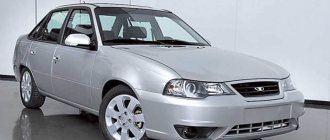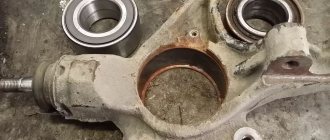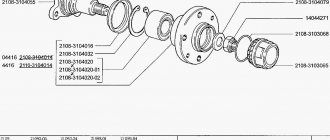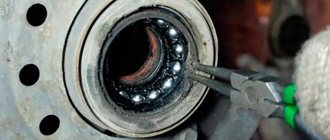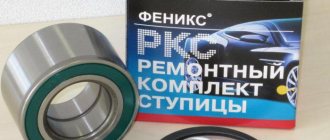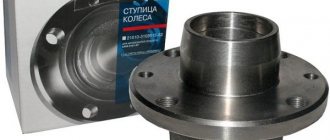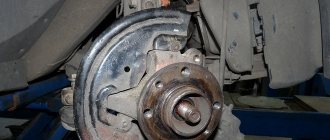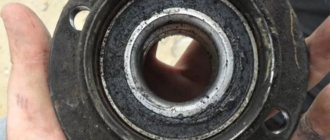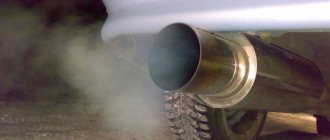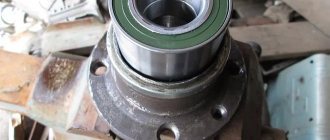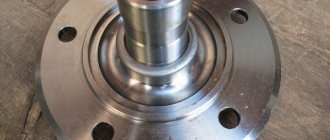List of companies
Well, now we come to the most interesting part.
Now I want to introduce several serious manufacturers that you can choose from. I want to say right away that I will not take Chinese and Russian brands, we will take a walk through the famous ones. 1) SNR is a large French company, widely represented in Europe, less so in Russia, but quality is practically in first place.
2) SKF is the world's largest company, ranks with SNR, and is widely represented in Russia. Very high quality manufacturer.
3) FAG is a leading manufacturer in Germany, not as large as the first two, but the quality is at the same level. Recently acquired by INA
4) NSK is the second wheel bearing manufacturer in the world after SKF. The headquarters is in Japan.
5) NTN - Japanese domestic manufacturer, rarely represented in Russia.
6) Koyo - part of the TOYOTA company, the third largest in Japan.
7) Timken is the first American manufacturer of bearings.
 INA is a very large concern, but it produces bearings for engines, transmissions and timing belts; it recently absorbed FAG, and therefore is beginning to enter the “hub” business under its own brand.
INA is a very large concern, but it produces bearings for engines, transmissions and timing belts; it recently absorbed FAG, and therefore is beginning to enter the “hub” business under its own brand.
I would like to note that some of these manufacturers work only for brands (conveyor) and practically do not work for the spare parts market.
Repairing the hub of Niva-21213 starcom68
How to Lubricate a Wheel Bearing Without Removing the Hub
Hub type 1. Manufacturer: VAZ JSC. Price 707 rubles in a store selling factory (?) spare parts. Rosstandart stamp.
Pay attention to how the place that comes into contact with the steering knuckle is designed. Here we see grooves of varying depths
Hub type 2. Purchased at the car market for 550 rubles. Manufacturer unknown. I purchased a hub of a similar design in Pskov several more times, since the loss of the original one. The difference is a slightly rougher surface treatment and the presence of an unfortunate yellowish ring at the point of contact with the end of the steering knuckle, where the factory hub has just a groove. Photographed after assembly with the brake disc.
Look - a hollow (U-shaped in cross-section) ring in the place where there should be a notch. When I first bought such a hub I asked what the hell it was
I was told that this was a “better” hub, so I continued to use this type of hub until today without paying attention to the ring and without being puzzled by its absence or presence
So today, after turning two different types of new hubs in my hands, I decided to see what the old ones looked like. They looked different. On the left is the left one, factory type 1, without ring. On the right is the right one with a ring - type 2.
Hub Type 1. Without ring, factory (?) Used for at least 4 years. The inner bearing has been removed. The outer one came out of place tightly, but its inner ring moves freely along the seat of the inner bearing and even spins merrily on it. The knurled collar prevents it from being completely removed. The oxidation layer (?) at the site of the outer bearing is preserved, but absent at the site of the internal one.
Hub Type 2. Used for a little over a year. The ring is heavily dented during use and shows signs of rotation and friction. The oil seal has not been removed, there are nicks on the seat from the chisel used to knock down the bearing
The seat for the inner bearing is worn, but less than that of the left hub; there is a fillet along the edge. It is because of this that the inner ring of the outer bearing cannot be removed, and in general the hub cannot be removed from the steering knuckle as required by the instructions.
Let's take a look at the steering knuckles. The left steering knuckle that worked with the factory hub. The condition of the contacting surfaces is almost perfect. O-ring (?) is in place and in good condition
The right steering knuckle, which worked with a hub with a ring. The condition is not very good. The sealing ring is crushed “to a cone” and has traces of friction during rotation against the ring on the hub. The oil seal is not pressed in completely, I realized this later, it is still recessed by 3 millimeters.
Now the actual questions: 1. How to achieve correct mating of the steering knuckle with the hub and ring (Type 2). Remove the ring from the hub or the knuckle? If both rings remain intact, they rub against each other and become deformed. Moreover, as I understand it, the correct (completely) seating of the bearings is not ensured.2. How far should you drive the oil seal in the photo above? Enough or all the way?3. Why do hubs fail so quickly and first of all the seats for internal bearings wear out, forming a shoulder? The bearings, most likely, would still be working if it were not for the need to disassemble the hub with a sledgehammer.4. How necessary is it to install spacer rings between the bearing and the seal? I only have one left, but I can’t buy it. And how is it installed correctly? Cone to the bearing or oil seal. I had a cone facing the oil seal, but I’m not sure it’s correct.5. Is it necessary to stuff lithol into the seals? Indications vary.
Well, as an epilogue, the machine is in progress. New steering rods made by Trek were installed, a front beam with a new pressed-in bushing, which turned out to be 1.8 mm shorter than the original one and also with chamfers removed from the inside, as a result of which the area of the pressing surface to the washers decreased by about 1.5 times . There is a risk that the washers will, if not rotate, then be pressed inward.
Bearing in the front hub
Changing the front wheel bearing on a Lada Kalina with your own hands
The process of replacing the front wheel bearing is labor-intensive and requires certain knowledge and skills. So, you will need quite a lot of tools: a set of large heads, screwdrivers and keys, as well as a medium-sized crowbar and two jacks. It is worth noting that the process of replacing a bearing with and without ABS is almost no different. For cars without ABS there is no hole for the speed sensor.
At the first stage, remove the wheel: engage the handbrake and first gear, unscrew the hub nut (key “30”). Loosen the four screws, and then use the jack.
Replacing a Renault Logan wheel bearing is not complete without removing the wheel arch liner. First, remove the bumper shield (two pistons and three screws). Then you need to get to the point marked by the arrow.
All fender liner mounting points
When the piston at the “important point” is removed, go through the remaining elements. These are four screws (1 and 2), two pistons in the front, as well as a self-tapping screw and pistons near the mudguard. In configurations with ABS, the following actions are carried out: disconnect the connector, remove the cord from the grooves (see
photo), disconnect and remove the sensor
In configurations with ABS, the following steps are carried out: disconnect the connector, remove the cord from the grooves (see photo), disconnect and remove the sensor.
The cord must be taken out of three grooves
All that remains is to remove the steering knuckle. But this operation is a long one.
Removing the brake discs
Let's try to remove the pads: move the bracket outward, unscrew the nut on the lower pin (key "13"), lift the bracket. The finger is kept from turning with a key “17”.
Down with the pads
We take out the pads, then remove the brake mechanism. To do this, use an 18mm wrench to unscrew the two screws. They hold the mechanism on the fist.
To prevent the disc from turning, you can temporarily tighten any screw that secures the wheel. A wedge is placed between the hub shoulder and the screw.
How to remove the steering knuckle
The tie rod end needs to be disconnected from the knuckle. To do this, use a 21 wrench to loosen the locknut, holding the tip itself by the flats (see photo).
Down with the rod tip
The most difficult thing will be to knock out the finger: loosen the nut with a 16mm wrench, and hold the finger itself with a Torx T30 wrench. Then we hit the end of the lever with a hammer. The pin must be pressed out completely, and the nut must be unscrewed at the end.
Let's move on to the suspension arm. The structure of the front suspension allows you to easily remove the stabilizer stud: use a 13mm wrench to unscrew the nut, holding the cap with a T40 wrench (see figure).
We only use a screwdriver and a wrench
Then, using a 16mm wrench, unscrew the nut of the coupling bolt. The “tie” is located at the bottom, and the “cheeks” of this tie can be opened with a screwdriver. The point is to bring the support down from the fist.
The simplest thing left is to unscrew the two screws on the stand. To do this, use the “18” key.
Attaching the steering knuckle to the strut
Removing the bearing
Using a vice and a thin mandrel, you will need to knock out the hub (see figure). In this case, the bearing is destroyed.
The old bearing will be destroyed
The outer bearing race is then knocked out of the knuckle. But first remove the retaining ring.
Let's consider all the steps in order:
- We separate the hub and fist (mandrel d=36.5);
- Using circlip pliers, remove the ring from the knuckle recess;
- We use a d=65 mandrel to knock out the outer ring.
Each step has a photo.
We got rid of the bearing by half
Now let's remove the extra part from our hub.
First, remove the washer covering the rubber seal. Next, move the bearing ring using a hammer and chisel.
Down with the other half of the bearing
At the last stage you will have to use a puller.
Bearing installation
First, the bearing is pressed in, then the retaining ring is installed, and then the hub is pressed in. In this case, a screw puller or a hammer and mandrels are used.
Tips for the ABS version
For trim levels with ABS, there are rules:
- Before installing the bearing, the sensor ring is installed. The legs of the ring “look” inward;
- Grooves 1 and 2 must match (see photo);
- The magnet on the bearing should “look” inside the fist.
Subtleties of crimping
The Renault Logan wheel bearing puller looks the same as the puller for AZLK-2141. The drawing is presented below.
Special tools from the AZLK plant
When working, follow two rules:
- When you press the bearing into your fist, cup 3 (72 mm) presses on the bearing;
- If the hub is being pressure tested, cup 4 (62 mm) is used.
In the first case, the spacer rests on the fist. In the second, it puts pressure on the hub.
Replacement with the rack not removed
Design and operation Wheel bearing. What are bearings for?
This method will allow you to avoid subsequent collapse. Here you need to remove:
- wheel together with disk;
- caliper and the hub itself.
Replacement is carried out directly on the car, without removing the rack. Here you will have to work with a puller. The procedure is performed like this:
- unscrew the bolts from the brake drum and remove it;
- remove the ball joints;
- pull out the CV joint from the front hub, and then remove it itself using a chisel;
- the retaining ring is pulled out from the steering knuckle (it contains the outer part of the damaged bearing);
- the puller is installed directly on the fist;
- by tightening the bolt of the device, the part is pressed out;
When it completely leaves the axle, the protection is dismantled, then the hub is removed, from which the inner race is removed.
You can also remove the latter without a puller, but you will need a chisel for this. It’s also quite easy to score with a grinder and then split with a heavy hammer.
Causes of drive failure
How to choose a vacuum cleaner for your car Cleaning the interior with an assistant
Replacing a vehicle's drivetrain is an infrequent occurrence, since the axle shafts are designed to withstand severe loads: factors such as gravity, tangential reaction associated with the start of the vehicle, lateral force, and even loads associated with strong crosswinds are taken into account.
Thus, the main reasons for failure and subsequent possible replacement of shafts are the following:
- an accident in which the wheel axle was thrown over an obstacle of appreciable height;
- daily long-term use of the car without proper attention paid to maintenance;
- leakage of the drive shaft boot.
Replacing bearings
The technology for replacing bearings on different types of suspension has minor differences. Before you begin replacing bearings, prepare the following tools:
- jacks;
- props;
- chisel;
- hammer;
- puller for replacing wheel bearings;
- a set of open-end and socket wrenches; pliers;
- pliers for removing retaining rings;
- flat screwdriver;
- WD-40 liquid;
- clean rags;
- wire or rope.
Preparatory actions
Hang up one or both sides of the axle, install supports, make sure that the machine is standing securely and will not fall if it moves awkwardly. Remove the wheels. Remove the brake caliper and hang it on a wire or rope to the body so that it does not interfere with work. Remove the brake disc.
Replacing bearings on the drive axle with constant velocity joints
Engage 1st gear and unscrew the constant velocity joint (CV joint) nut. Using the correct size bolts or studs (cylinder head bolts will fit on most vehicles), screw the brake rotor to the hub. Tighten the bolts 5–7 turns. Bring the disk to the hub, and then pull it towards you so that it hits the bolt heads, this is necessary to remove the hub from the fist.
Unscrew and unscrew the steering pin nut, then remove it using a puller. Unscrew the ball joint mounting bolts and move the strut so that the CV joint shaft comes out of the knuckle. Remove the retaining ring securing the bearing in the knuckle and using a puller, remove the bearing. To do this, install a large ring outside the knuckle, and place a mandrel with a diameter slightly smaller than the diameter of the bearing against the race.
Tighten the puller nut and it will push the cage out. Wipe the seat with a rag and use a puller to install a new bearing. Then, also using a puller, put the hub in place, screw on the ball joint and steering pin. Don't forget to tighten the pin nut.
Replacing bearings on the front axle of rear-wheel drive cars
Remove the protective cap that covers the hub bearing and unscrew the nut. Remove the steel washer and oil seal, then remove the hub. If you can't do it with your hands, use the method described above. Remove the old bearings (two pieces) from the hub using a screwdriver and a spacer ring of two halves (on some cars it is whole)
If that doesn't work, carefully knock them out with a chisel. Thoroughly clean the hub of grease and rinse in diesel fuel or gasoline
Dry with compressed air. Lubricate the inside of the hub with lithol, then using a mandrel of the appropriate diameter (you can use the outer race of the old bearing) install the race of the first bearing. Thickly lubricate the cage and bearing rollers with lithol and insert it into the cage. Install the spacer ring, then, after lubricating the hub, press in the second race. Reinstall the hub, fill it with lithol and insert the second bearing cage. Reinstall the seal and washer.
Replacing bearings on the drive axle with axle
Unscrew the nut securing the axle shaft, remove the steel washer and oil seal. Remove the hub
If there is a separator left on the axle shaft, carefully remove it with a chisel, then use a small needle file to remove any burrs on the axle shaft. Replace the bearings in the same way as for the front drive.
Replacing bearings on the rear axle of front-wheel drive vehicles
Unscrew the hub securing nut, remove the washer and oil seal. Remove the knuckle hub and replace the bearings using technology for the front axle of front-wheel drive vehicles.
Final actions
Tighten the nut while rotating the hub. As soon as you cannot turn the hub with one hand, unscrew the nut ¾ of a turn. Using a chisel, drive the nut into the grooves of the CV shaft, axle shaft, or knuckle pin. Don't forget to core the nut. Reinstall the brake disc and caliper. Screw on the ball joint and steering pin. Install the wheel, lower the car and remove the tools.
Conclusion
Replacing a wheel bearing is a simple operation accessible to any car owner. Using the tips from the article, you can change the bearing yourself. The main conditions for successful replacement are knowledge of technology, appropriate tools and compliance with safety regulations.
Replacing the wheel bearing on Niva. Sequencing "
Wheel bearing: 4 simple ways to check before it's too late
Replacing the wheel bearing on Niva. Sequencing
As a rule, the bearings or driveshaft most often make themselves felt in rear-wheel drive models. At first, the situation is not so critical and the driver can safely endure the inconvenience, but over time the cup overflows and being in the cabin is simply unbearable. And then, willy-nilly, you go to the repair shop and change spare parts.
Replacing a wheel bearing on a Niva is slightly different from its “sisters”, this is due to all-wheel drive, since the wheels must be designed to rotate from the gearbox. Those wishing to carry out repairs should immediately carefully read the requirements of the operating instructions from the manufacturer, otherwise you will waste a lot of time.
The quality of roads, driving style, originality of spare parts, this is not a complete list, which directly or indirectly affects the service life of the wheel bearing. Structurally, the car wheel and the axle shaft are connected to each other by a hub.
The shape of the bearings resembles cones, hence the name - conical.
A special feature is that only the Niva car has the ability to adjust the gap between the bearing and the hub. Over time, any mechanism wears out and becomes thinner. To extend the service life, engineers came up with this adjustment method.
Remember, too much tightening will cause the wheel to jam, and too little tightening will cause it to break. It is necessary to clamp with a dynamometer with certain readings.
- We drive onto a viewing hole, lift or overpass;
Remove the corresponding left or right wheel;
By unscrewing the two nuts, remove the brake caliper and move it to the side so that it does not interfere with the process;
Using a chisel, unbend the lock washer;
Using a cape or unscrew the hub nut;
We carry out the same actions with the rear lock nut;
Having removed the rotating mechanism from the mounting bolts, we move it to the side for convenience;
Then disconnect the brake hoses;
Using a spanner wrench, unscrew the lower and upper fastenings of the ball joint;
We remove the hub as a complete module.
Useful tips
By following these guidelines you will ensure that your new bearings last longer:
- when replacing a damaged part, place a new one on both front wheels, so the entire system will work more stable (after the procedure, the wheel alignment is checked);
- the bearing is cooled before use, and the rotating mechanism, on the contrary, is heated, this will allow pressing to be carried out with minimal labor costs;
- try to buy new spare parts in stores with a good reputation that have the necessary certificates of conformity and other documents confirming the quality of the products sold.
Front hub VAZ 2109
Measure Before Buying
Identifying a wheel with a damaged bearing
It’s worth making a reservation: the howl of a wheel bearing can be confused with the hum of the gears of a gearbox or rear axle gearbox (both of which immediately bring to mind an outgoing train). The latter sounds are similar, however, the car makes them only in certain modes: during acceleration or after you take your foot off the gas pedal. Sometimes the noise goes away when the clutch is depressed. The wheel bearing will hum whenever the car is moving. How to find out which wheel has the problem spare part? Fault detection algorithm:
- while driving, listen to where the hum is coming from: from behind or from the front, if it is not clear, go into a turn - a faulty front bearing will make more noise after exiting the roll;
- Having determined the source of the hum, put the car on a jack and check both wheels one by one: rock them in the vertical and horizontal directions - a large play will indicate the “culprit”;
- for a more accurate determination, ask an assistant to press the brake while checking: if the play remains, the wheel bearing is probably damaged;
- another indirect sign: vibration of the wheel, if you spin it manually - this indicates the wear of the rollers and the separator itself;
- put the car on a lift, start the engine and accelerate the wheels, then turn off the engine: a crunching sound and or other uncharacteristic noise will come from the faulty side;
- at a speed of 60 km/h, provided there is no oncoming or passing traffic or other obstacles, “throw” the steering wheel for at least 4-5 seconds: provided that the wheel alignment is pre-adjusted, the car will be pulled to the side.
There is another diagnostic: after a trip, touch the rims and compare: the damaged element heats up more than the good ones. And another method for identifying a damaged part (if it is in the front) is to move in a “snake” (like on a race track) at a speed of 50-60 km/h. When turning left, the right front bearing will make noise and vice versa. It is not possible to check the malfunction of the rear parts using this method. Here is another symptom: a change in the nature of the hum as the speed increases or decreases; Also sometimes the brake pedal starts to vibrate when you press it.
Lada Granta vLada granta › Logbook › Wheel bearings
I am already observing the third generation of hub assemblies: the first is tapered bearings (roller), two per hub, with an oil seal (s), lubricant and gap adjustment (although there are designs with guaranteed interference when stacked spacer washers are inserted between the inner races).
The second generation is double-row ball (roller) bearings with guaranteed interference (with unregulated clearance, tightened with a large torque). The third generation - non-separable bearing units. On Russian roads (potholes and potholes), it is preferable to use roller bearings, which provide greater resistance to shock loads due to the linear contact patch (roller - cage). Today I changed the rear wheel bearing on a Renault Megane - 2 (the same on Logan) - a roller bearing, second generation (ran 150 tkm). For VAZ PP, at the Vologda Gas Processing Plant (if I’m not mistaken) at one time they produced such (roller) bearings, but they did something wrong - backlash developed during operation. Impacts are contraindicated for ball bearings. Under any shock load (potholes, curbs, accidents, blows to the hub with a heavy hammer when replacing a brake disc and knocking out a stuck CV joint from the hub), pinpoint punctures (scratches) occur on the mirror surface of the treadmill, which then roll out into shells (pitting), when Rolling the balls over the shells creates a vibration with noise, which is sharply transmitted to the body. Ball bearings are more technologically advanced and have lower rolling friction losses compared to roller bearings. The fact that they are not suitable for bad roads does not concern foreign manufacturers. We will have to put up with this in the future. Therefore, it is necessary to protect the hub bearings from shock loads and flooding with water (this includes tire pressure and non-standard wheels and the speed of movement in pits and puddles with fords and hard shock absorbers and repair manipulations). Also, you need to change the bearings only when they become unusable - to protect your loved ones (most likely you will no longer come across bearings of the same quality). No paired or prophylactic replacements. Many car enthusiasts noticed that previously, on old cars, bearings lasted almost forever. Yes, this is a fact, I think there are several reasons - firstly, in my opinion, modern cars have much more stringent wheel rolling conditions - hard rolling radial tires, reducing the height of the tire profile, increasing the diameter of the wheels, increasing the width of the wheels, rigid suspensions (gas-filled struts with a ratio forces 1/1), ABS vibration. Secondly, spare parts (I think that the “original” bearings are now no worse than before), but what’s in the spare parts is a dark forest. A very murky topic, I know for sure that the inscriptions “made there” can quite legally appear on parts made in China for pennies. The main thing is that the legal address (office) of the manufacturer is located in the desired country. Replacing double-row bearings with guaranteed interference is a responsible undertaking. For VAZ - 2108 -18 I have a screw puller, I change the bearing on the spot (without disturbing the camber angles). For larger bearings, pressing the bearing out of the knuckle with a screw puller is a dubious thing, because the friction of the interference fit exceeds the capabilities of the puller thread (a 20-ton hydraulic press is needed). In addition, for each fist, its own equipment is necessary due to the different shape of the supporting surface (not only the diameter) ... In order not to harm the car, when replacing a bearing of this type, you must strictly follow the rules: - If the bearing is changed on a car, then the hub from The inner race can be pressed out with a puller or a reverse hammer, and the outer race can be pressed out of the fist and pressed in only with a puller. — From a knuckle removed from a car, you can press out the outer race with a press or a puller; the main thing is to have a variety of equipment that prevents damage and deformation of the knuckle. - When pressing the outer race into the fist, ensure that the pressure of the press or puller is applied only to the end of the ring of the outer race (no pressure on the inner race is allowed) - for this you need to use dies with recesses on the inside (I always use the race of the old bearing) - When pressing the hub into the pack of internal races of the bearing, the emphasis on the back side of the bearing should be placed only on the inner race (during the entire pressing process, free rotation in the bearing must be ensured) - Tighten the hub nut with the torque recommended by the manufacturer. The seals of a double row bearing must not be opened. Do not add lubricant under the boot (at high rolling speeds of the balls, excess lubricant will be squeezed out and break the seal of the boots). You cannot disassemble a double-row bearing (remove the inner races from it). I began to notice that more and more often double-row bearings of modern budget cars began to fail due to water penetrating inside them... I think this is because modern automakers do not bother at all with the complexity of bearing seals (previously there were water-repellent “labyrinths”, like on the VAZ PP, and now the bearing seal is freely allowed for splashes from under the wheels)… In addition, high-pressure car washers have become widespread (you shouldn’t get carried away with washing wheels and chassis with such intense water pressure that a high-pressure washer produces)… And there is also an idea that Manufacturers who have calculated the seal capacity of modern bearings have calculated it for the properties of ordinary water. And water with detergents or with our road reagents has much greater penetrating power than plain water. This is why wheel bearings have such a short lifespan in our conditions today. Checking the hub bearing for noise Wheel bearings are checked for noise in a room where it is relatively quiet. Each of the four wheels (or the entire car on a lift) is sequentially suspended from the gearbox in neutral gear. Stand on the side of the center of the wheel. Grab the wheel with your right hand (carefully so that your fingers do not get under the caliper or rub against anything when turning the wheel with your hand). You can rotate the wheel on the bearing with your right hand half a turn to the right or left, you can spin the wheel many turns with acceleration clockwise, for example. The free hand (left) should rest on one of the suspension parts (on the strut, strut spring, lever...). ———————— If there is noise in the bearing, then “hard rolling of the bearing” will be observed. This will be felt by your left hand in the form of vibration on the suspension parts. This will be audibly felt in the form of low-frequency noise (the rustle of the pads, the noise of the satellites in the gearbox do not count). The sensation of vibration is as if you put a small bearing on your finger and rolled it over a smooth oiled sheet of metal (no vibration), and then rolled it over a large rasp (there is vibration). ————————- A slight play in the hub (without noise) is not a sign of a defective bearing, although wear on treadmills is often accompanied by play. About the fact that if the noise intensifies when turning left, change the right wheel hub bearing. Many drivers have experienced noise and vibration while driving from the hard rolling of faulty wheel bearings. There is an opinion that by the nature of changes in this noise when cornering, you can find out on which side of the car the wheel with a faulty wheel bearing is located. It is believed that increased hub bearing noise when turning a corner indicates that the bearing of one of the wheels moving along the outer radius of the turn is humming. It is also believed that when a wheel moves along the inner turning radius, the noise of a faulty bearing in the hub of that wheel should subside. In practice, this rule does not always work. Most modern cars have double-row ball (or roller) bearings in their wheel hubs. The wheel of a car moving around a turn perceives a weak lateral reaction from the road, applied in the contact patch of the wheel with the road. This reaction is directed towards the center of rotation. At the same time, the same magnitude of force acts on the wheel axle from the side of the car, directed from the center of rotation. These two differently directed forces acting on the arm of the wheel's rolling radius create a strong moment that tends to tip the wheel outward from the center of rotation. Similar moments, identical in direction, act on all four wheels of a car moving around a turn. This “tipping” moment acting on the wheel selects play in the double-row wheel bearing and loads the raceways on the outer bearing race differently. The wheel bearings of the right and left sides of the car are loaded when turning in the same way. A malfunction of the wheel bearing, which causes noise with vibration when the car is driven, is caused by the formation of cavities on the raceways of the bearing races. If the shells are located in the upper part of one of the raceways of the outer race of the wheel bearing (this is usually the case), then the increase or decrease in bearing noise during turns will be determined only by the direction of the turn, regardless of whether this wheel is moving along the outer or inner radius of the turn. Therefore, the method of identifying a faulty bearing by changes in noise when cornering should be used only for preliminary diagnostics. original "hodovik-razval"
Necessary tool for working on VAZ 2109
The complexity and speed of the repair directly depend on the availability of special tools. There is a minimum required set:
- a hammer (where would we be without it) and a wooden block or small board;
- pliers for removing retaining rings (an alternative is an awl or a thin screwdriver);
- key or socket for 12;
- 30mm head with a knob (to make it easier to unscrew, lengthen the knob using a pipe).
To speed up, additionally use:
- three-legged hub puller;
- two-legged puller for the inner race of the bearing;
- universal puller for pressing/extruding;
- chisel.
For alternative methods without using pullers, see further in the instructions.
When choosing a bearing, pay attention to Saratov bearings marked SPZ and Vologda bearings (VBF). Bearings from Samara have a bad reputation, and imported ones are not worth the extra money
Therefore, the first two options are the optimal combination of price and quality.
Review of manufacturer prices for front and rear hinges
How to choose and buy quality parts
Service center specialists strongly recommend purchasing consumables and components exclusively from specialized stores, representative offices, and official dealers.
To a lesser extent, you need to use the services of unverified suppliers who sell spare parts at an unusually low cost.
When purchasing, check the catalog numbers with the actual data specified in the operating instructions for the technical device. If such a brochure is not available, consult a specialist.
Is it worth buying the original?
It is often advised to buy original bearings. An original is a part selected by a car manufacturer for sale on markets. These are the parts that are delivered to conveyors. When buying an original bearing, you will be absolutely sure that it will suit you. But there are several questions that need to be addressed here.
The original or a fake?
The original bearings are all the same and if you examine it carefully you will find the engraving. It is located on the edge of the upper or lower part. It should contain several information:
- manufacturer (logo);
- Country of Origin;
- designation digital or alphanumeric details, sizes;
- Additional information is possible;
- The kit must include a hub nut (usually disposable), there may be pins or bolts, seals.
- SKF brand
- Full bearing designation
- Manufacturer country
- Production date code
- Deviation of the average outer diameter ∆Dm and the position of the maximum eccentricity of the outer ring
- Deviation of the average bore diameter ∆dm and the position of the maximum eccentricity of the inner ring
- Marking of thrust end, stamping
- Serial number (for bearing sets only)
- "V" marking (matched bearing sets only)
If the country of origin is not indicated, it is not an original, but a fake.
Is it worth paying extra for the original?
As a rule, you will find completely similar bearings from different companies on the market.
So is it worth paying more for the original if other companies produce the same parts? If you decide to pay attention to any company, then choose well-known, popular manufacturers that supply parts to conveyors. Some people prefer Japanese companies, others prefer European products, for example, they trust only German quality
Our rating of the best manufacturers will help you determine which wheel bearing company is better and who to give preference to. Even if these companies offer products made in China, they will be high-quality products that meet all the requirements. Pay attention not to the country of origin, but rather to the supplier’s brand.
Select a vehicle modification to search for a wheel bearing
Engine: volume - 1.4 liters, power - 90 hp, type - petrol, model - VAZ-11194. Drive: front. Year of manufacture: 2008-present. time
Engine: volume - 1.4 liters, power - 88 hp, type - petrol, model - VAZ-11194. Drive: front. Year of manufacture: 2008-present. time
Engine: volume - 1.6 liters, power - 82 hp, type - petrol, model - VAZ-21114. Drive: front. Year of manufacture: 2004-present time
Engine: volume - 1.6 liters, power - 84 hp, type - petrol, model - VAZ1110. Drive: front. Year of manufacture: 2010-present time
Engine: power - 82 hp, type - electric motor. Drive: front. Year of release: 2013-present time
In the next step, for an expanded selection, you can enter the vehicle's Vin code to go to illustrated catalogs, where you can find the layout of parts down to the bolt and duplicates that are not in the catalog of analogues.
Dear customers, in order to avoid errors when sending a front wheel bearing, please indicate your car model, year of manufacture, front or rear in the “Comment” line.
All VAZ cars are equipped with only three types of wheel bearings - wheel bearings for front-wheel drive VAZ cars, wheel hub bearings for rear wheels, and wheel bearings for Kalina and Grant cars, which are smaller in size.
Hubs play a very important role. Without them, the wheels will not rotate at the required speed, which will first lead to damage to the brake system, and then to failure of the entire car.
The front wheel hub is a rather complex forging. In the front wheel hub there is a double-row angular contact ball bearing, into which a driver with an internal splined cylindrical surface is inserted for the splined end of the drive shaft. To protect the hub, there is a cap covered with dirt-reflecting rings.
The bearing is of the HUB-1 type, has a double-row design, is a type of angular contact ball bearings with closed working surfaces and does not have flanges for attachment to the hub, which does not require lubrication and adjustment during vehicle operation.
The drive shaft is secured in the driver with a self-locking nut and washer. The nut has an external hexagonal key, thread M 20 x 1.5, tightening 290 Nm ±10%.
If you hear a noise, a characteristic noise or a certain hum in the front part of your car, which only intensifies when entering a turn, this indicates the need to urgently replace the front wheel bearing on your VAZ 1118, 2170, 2190, 2192.
If the hum is heard on only one side, then only one bearing is damaged. But most likely the second one doesn’t have much time left either. Buying two bearings as a set will be cheaper than buying them separately.
When pressing out the wheel hubs, the bearings are destroyed. Therefore, pressing out the hubs should be carried out only in cases of increased bearing noise or a significant increase in the gap in them: more than 0.015 mm in the front and more than 0.030 in the rear.
Other articles of the product and its analogues in the catalogs: 11180310302000, T-02148, KT 100534, 11180310302004.
VAZ 1117-1119, VAZ 2170-2172, VAZ 2190, VAZ 2192-2194 (Kalina 2), VAZ 1117-1119, Largus, Datsun.
Any breakdown is not the end of the world, but a completely solvable problem!
How to independently replace the front wheel bearing on a VAZ family car.
With the AvtoAzbuka online store, repair costs will be minimal.
Just COMPARE and BE SURE.
Don't forget to share the information you find with your friends and acquaintances, because they may also need it - just click one of the social networking buttons located above.
Bearings for cars of the Russian automobile industry
The domestic auto industry, which produces passenger cars, still uses old types of bearings in production - single-row roller bearings. Only AvtoVAZ switched to two-row closed hub type HUB-1. HUB-1 means there are no flanges on the body for mounting to the hub. Therefore, owners of Russian car brands have a question about which wheel bearings are better. The most common vehicles on Russian roads today are VAZ 2110, GAZelle, and UAZ Hunter. Of course, you can purchase original parts, but they are often twice as expensive as similar ones from other factories. Let's look at the example of these particular brands of companies that produce the necessary parts.
Bearings for VAZ 2110
For the modern line of VAZ passenger cars (except Niva 4x4, Chevy Niva), three standard sizes of wheel bearings are produced:
256907 - for front-wheel drive VAZ 2108-2112;
256707 - on Granta, Kalina;
All these models belong to HUB-1, double-row, ball, closed, angular contact. Lada Granta and Kalina differ only in height.
Traditional suppliers of bearings for cars from Togliatti are 5 - manufactures and sells original Lada wheel bearings through secondary markets;
Saratov plant - produces parts under the SPZ brand;
Volzhsky Plant - uses the Volzhsky Standard brand;
Vologda plant - sells products under the VBF brand;
The price-quality ratio of these factories is optimal. The cheapest products are those from the Samara plant (less than 200 rubles), other companies on average sell parts costing 230-275 rubles.
Bearings for UAZ
UAZ hubs use bearing 127509 - roller, conical, single-row, angular contact. There are additional parts marked: A - reinforced and AK - with minor design changes. The part can withstand large axial loads, so the car can be operated in difficult road conditions.
Parts of this type are produced by the Samara and Saratov plants, already mentioned above, as well as the Moscow GPZ-2 and Lutsk (LPZ) plants.
The most affordable products are from GPZ-2, the cost is 182 rubles.
Bearings for GAZelle
The front hubs of GAZelles are equipped with two tapered bearings, roller, angular contact, single-row. The outer one is marked 7305АШ, the inner one is marked 7307А. Both are designed to handle heavy loads.
Such bearings are manufactured at the Volzhsky and Saratov plants. The kit often consists of two bearings, fasteners, lubricant, stopper, and seals. The cost of such a kit from VPZ is 350 rubles.
In addition to Russian manufacturers, there are foreign companies that produce similar products, but prices are usually higher.
Before purchasing parts for hub repair, carefully study which suppliers offer the highest quality products, and check that the parts have the appropriate engraving. It’s better not to try to buy cheap, low-quality parts, because your safety depends on it, and such “savings” can lead to a major breakdown and a serious accident.
The best prices and conditions for the purchase of new cars
Replacing the front hub of Lada Granta
- We place the car within the perimeter of the repair area and provide priority safety measures.
- Let's jack up the right (left) side.
- Unscrew the bolts and remove the wheel.
- Let's unlock the hub.
- On the back side, unscrew the two bolts that guide the brake caliper.
Location of two bolts
- We remove the caliper, hang it on a wire (we fix it on the steering tip).
- Unscrew the hub nut and remove the brake disc.
Removing the hub nut
- We unscrew the two bolts - the rack clamps. If necessary, we use a liquid to remove deposits like WD-40.
- Disconnect the strut with the steering knuckle and unscrew the ball joint fasteners.
- We remove the CV joint.
Next, install the new hub assembly and assemble the structure in the reverse order.
Replacing the front wheel bearing of Lada Granta
- The front hub joint is located in the steering knuckle housing, remove it. Pre-clamp the structure in a stationary vice.
- We install the metal spacer - the head at “22” on the surface of the hub. We apply targeted blows with a hammer to press it out.
- We disconnect the inner race of the hinge and remove the separator with metal balls.
- To remove the outer part of the hinge, use pliers and remove the retaining rings.
- To dismantle the inner part of the cage we use a chisel. Gently tap with a hammer. Press-out puller
- Use a puller to press out the axle shafts.
Pressing in a new wheel bearing and assembling the unit
- We clean the surface from dirt, deposits, and rust. We remove the old grease from the hub and wipe it with a rag. We measure the diameter of the hub, it should be 35 mm.
- Apply a thin layer of graphite grease to the surface. Press in the new bearing.
- We press the hinge until the retaining ring comes into contact with the edge of the part.
- We insert the hub into the hole using a vice.
How to change the rear wheel bearing
It is very easy to replace the rear wheel bearing of Lada Priora, for this you need:
- remove the hub cap and unscrew the hub nut;
- jack up the car and remove the rear wheel;
- remove the brake disc;
- remove the hub assembly; if the hub race remains on the axle, it must be removed with a special puller.
After dismantling the unit, press the bearing out of the hub and install a new part in place. To assemble a bearing with a hub, a press is mainly used, but pressing can be done in another way:
- heat the hub to 60-70ºC (it is best to do this with a hair dryer);
- cool the bearing (for example, put it in the freezer).
After changing the temperature conditions of the parts, the bearing enters the hub without delay, but you cannot hit it, otherwise it will immediately hum after installation. Wheel bearings should also be replaced in pairs.
Types of bearings
Let's look at the hub bearing as it appears on the chassis
We will pay special attention to SNR. This model is one of the most common bearings on the market.
The best device is the SNR, which is a rolling bearing. Since it is precisely this that provides the greatest resistance to the movement of the car. Additional details are also used. This is about:
- radial ball bearings,
- roller with radial,
- roller conical shapes, they are also resistant to the radial.
The SNR type wheel bearing has a specific design that is different from other parts. With an independent front suspension and a driven rear axle, it is necessary to install two tapered bearings in front on each side and a single radial bearing in the rear
It is also important to remember that lubrication is needed, otherwise the device will crack, creak, and wear out, which will quickly damage it. But it cannot be repaired, it must be removed and cannot be put back, since many parts will be damaged
The housing must be filled with lubricant sufficient to last the service life of the bearing. The lubricant cannot be changed, as the seal of the anthers is broken. You can notice that the wheel bearing includes three parts. This is the one that is located inside, there are also rollers on the outside.
Diagnosis of wheel bearing failure Grants
The front wheel bearing on the Grant is not the most vulnerable part in the suspension, but its failure is possible after a mileage of 80,000 km or due to external and internal factors. A malfunction of the front hub is determined by the following signs: - Noise from the wheel while driving (damaged ball bearing parts: rolling elements, raceways or cage); — Vibration, wheel beating, grinding (typical of a broken ball bearing); — Front wheel play (the ball bearing has failed or the wheel nut is not tightened with sufficient torque). — Watch the video with the characteristic noise when a hub unit breaks:
Price comparison for the front hub of the Cherie Fora A21
You can look at the prices that auto parts stores and dismantling shops previously offered to our visitors who were looking for a front hub for a Cherie Fora A21. This will help you understand how much on average you can buy a front hub in Moscow, including taking into account the cost of delivery by transport companies. You can contact the stores and check the availability and cost of parts, but we recommend that you save your time and simply send a request to all stores at once. When sending a request, we recommend that you indicate the VIN of the vehicle, this will allow you to correctly select the part you need.
Offers from stores and showdowns Cherie Fora A21
| Request: | Voronezh front hub 2 pieces Chery Fora A21 2009 sedan. Type of spare part: new, only in stock, in Moscow |
| Answer: | from 1,750 rubles !Contract internal combustion engines and gearboxes are also available - upon request.el-zap.rf/registration.html |
| Request: | Voronezh front hub 2 pieces Chery Fora A21 2009 sedan. Type of spare part: new, only in stock, in Moscow |
| Answer: | A21-3001030 Hub FORA lane (B11) A21-3001030 4 days 2,200 rub . 1 PC |
| Request: | Headlights left fender bumper front hubs Cherie Fora A21 2011 sedan. Type of spare part: new or used, in stock or to order, in Moscow |
| Answer: | Headlights - 2570 rub . left fender - 1850, bumper - 1833 rubles , front hubs - 1997 rubles . |
| Request: | Headlights left fender bumper front hubs Cherie Fora A21 2011 sedan. Type of spare part: new or used, in stock or to order, in Moscow |
| Answer: | RIGHT HEADLIGHT 1700 RUB BUMPER FRONT LINING 1000 RUB FRONT LEFT FENDER (ORIGINAL) 2300 RUB FRONT HUB 1600 RUB All in stock, new |
| Request: | Headlights left fender bumper front hubs Cherie Fora A21 2011 sedan. Type of spare part: new or used, in stock or to order, in Moscow |
| Answer: | Headlight 2800 new in stock Wing 2000 new front bumper available. 1800 new in stock hubs 2000 new order one day |
| Request: | Front hub Chery Fora A21 2005. Type of spare part: new or used, in stock or to order, in Moscow |
| Answer: | original 2500 available, not original 2000 |
| Request: | Front hub Chery Fora A21 2010. Type of spare part: new or used, only in stock, in Kinel |
| Answer: | 2400 rub . Wait 4-5 days |
| Request: | Front hub Chery Fora A21 2010. Type of spare part: new or used, only in stock, in Kinel |
| Answer: | A213001030 Chery Hub FORA front price 1789.98 rub. delivery time 2 |
| Request: | Front hub Chery Fora A21 2010. Type of spare part: new or used, only in stock, in Kinel |
| Answer: | Good day.CHERY HUB ASSEMBLY 1,941 rubles . Analog: Kroner CHERY Fora (06-) F 3,136 rubles . For more detailed consultation, contact us 89277127467 - +7(846)922-74-67 - Dmitry |
| Request: | Hub with bearing Chery Fora A21 2009 sedan. Type of spare part: new or used, only in stock, in Moscow |
| Answer: | 1500 rub . hub assembly with bearing. I will send any transport. |
